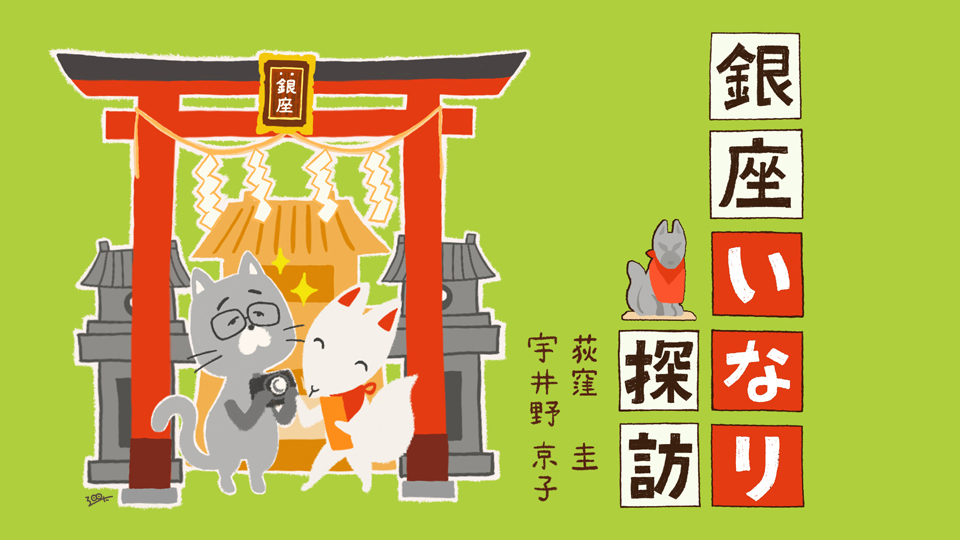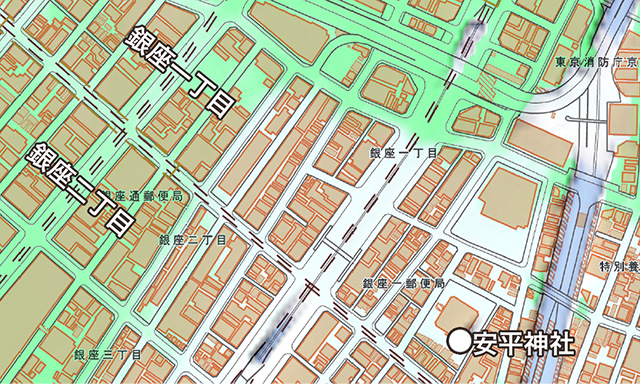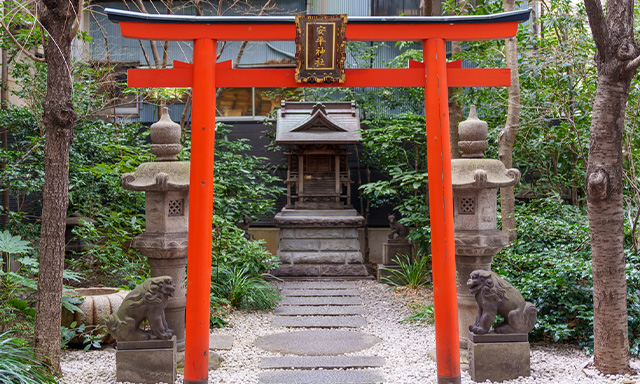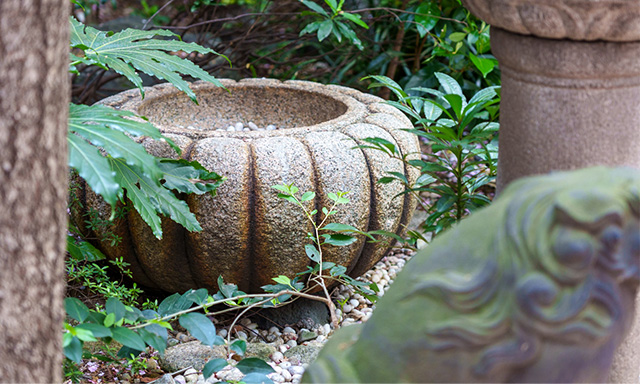
Visit Shrines

Visit Ginza’s Inari Shrines Vol. 18 Yasuhira Shrine
2024.05.01
Estate Inari Shrines are usually protected with care as shrines sitting on private property. However, with the changing times, sometimes they become exposed to the world outside to become guardians of the local community. Would that release its stories from its history which would only be known to the manager of the shrine? Such developments seem to be determined by fate..
- Uino
- We have visited many shrines. This time we will visit a shrine that I know little of and I had thought it would be difficult to introduce it in this series. Its name is Yasuhira Shrine.
- Ogikubo
- I also happened to passed by it. It is a very new shrine but there was no description of its history. What brought you to make this visit?
- Uino
- I had been thinking of wrapping up this series on Ginza’s Inari Shrines when a friend introduced me to the owner of the property that Yasuhira Jinja sits on. He is from the family who ran the restaurant that the shrine originally guarded. I was very fortunate to be able to contact him in this timely manner.
- Ogikubo
- Now that really sounds like the work of God.
- Uino
- Let us visit it first. This is an open area, or should I say shared space, of Ginza Tower, a high-story condominium. The greenery is beautiful.

- Ogikubo
- This is former Kobikicho, on the other side of Sanjikkenbori River. It has that unique atmosphere of a traditional area in Tokyo mixed with narrow streets with old houses and new high-story residential complexes.

- Ogikubo
- The condominium looks very new. It says it was built in 2003.
- Uino
- Before it was built, there was a restaurant called Manyasuro.
- Ogikubo
- A few years before 2003 is very recent. I didn’t know of it since I do not come to this area very often.
- Uino
- Ogikubo san, it was more than 20 years ago. That is not so recent (laughs). What do you think was here before Manyasuro? It was the manor house of “Shinjo Mino-mori (Mihagi-mori)” a “hatamoto” (direct retainer of the Shogunate) with 1,000 goku

This later became Manyasuro.
- Ogikubo
- The Shinjo clan has a long history, and its ancestor was a vassal of the Asai family who was sought by Oda Nobunaga. This estate was a Hatamoto of a branch family, and it seems that he was a “Goshoin banto” (secretary and head of the guard of the shogunate), an important position in the Edo Shogunate.
- 宇井野
- Yes, this shrine was originally its estate deity. When the land of the Shinjo family’s residence was purchased in the Meiji era (1868-1912), the garden was kept as it was and utilized as a garden for a ryotei (Japanese-style restaurant). When it was the Shinjo family’s estate, there was a hill in the garden where the shrine stood. Manyasuro succeeded the shrine, built a shrine and a torii gate, and arranged it so that weddings could be held there. The shrine was named Yasuhira Shrine. The original deity of the shrine was not and Inari deity. The Inari was enshrined during the Manyasuro ownership.
- 荻窪
- The original deity seems to be unknown. It may have been the Shinjo clan’s clan deity. Anyway, that is how the Manyasuro garden and estate Inari came into being. When I consulted various documents about Manyasuro, I found that in the “Tokyo Suburban Tourist Guide” of 1902 (Meiji 45), it said, “the beauty and extent of the magnificent garden of the house is unparalleled” and in “Kyobashi Hanjoki” of 1912 (Taisho 1), it was commented that it was “a disgrace for anyone not to know Manyanro as a restaurant.” It seems that Manyasuro was a reputable ryotei restaurant famous for its spacious garden. It is remarkable that a sightseeing guide would write so. According to a map from 1911 (Meiji 44), it seems to have been located in the area marked by this square.

The property marked in a squared was all the premises of Manyasuro
- Uino
- It is really spacious!
- Ogikubo
- What happened to Manyasuro?
- Uino
- They no longer run a restaurant, but their company, Manyasuro Co., Ltd. manages Ginza Tower. The land also still belongs to Manyasuro. When the tower was built, the owner had strong intensions to save the shrine and thus secured the adjacent land so that the shrine could be moved.
- Ogikubo
- That makes me want to know how the place looked when Manyasuro was still here.
- Uino
- Hence I have borrowed a picture from back then from Manyasuro san. This is Manyasuro in 1930 (Showa 5). The original building was damaged in the Great Kanto Earthquake and the shape of the property was altered in the plot development following, and they reconstructed their building. This is the new building.

It was obviously a very large ryotei restaurant.
From “Manyasuro Postcards”
- Ogikubo
- It says “Onsen Ryotei”. One could take a bath and have dinner as well.
- Uino
- I was told that it was a ryotei restaurant where on could take a bath, enjoy the view of the garden and be entertained by Geisha. It was something like a “Super Sento” with a karaoke companion. It seems that you could book not only Geisha from Shintomicho but also Shimbashi Geisha.
- Ogikubo
- In the picture, it looks like Yasuhira Shrine stood on an artificial hill. There were foxes in front of the current main shrine as well. If you look at the foundation, it says “Showa 5”, so it must have been placed when Manyasuro was rebuilt after the earthquake.

- Uino/dt>
- I have a picture from back then, If you compare the fox and main shrine, you can see that they are the same.

From “Manyasuro Postcards”

This has been succeeded by the current Yasuhira Shrine.
From “Guide to Kappo Restaurant Manyasuro”
- Ogikubo
- This is a valuable photo. I can imagine the artificial hill beyond the garden lake where the deity was enshrined.
- Uino
- I wonder why they named it “Yasuhira”.
- Ogikubo
- Perhaps they took the “Yasu” from Manyasuro’s name. “In peace and tranquilty.” It is a good name.
- Uino
- The Shinjo family was a branch of the so-called “tozama (external)” family, but they held important positions in the Shogunate for generations, and later overcame the Meiji period. The present Manyasuro continues to maintain the Yasuhira Shrine in the midst of turbulent times. This shrine, just as its name suggests, must bring considerable blessings to those who wish to spend their lives in peace and tranquility.
- Ogikubo
- It is also impressive that they did not leave the estate deity, which was originally enshrined in the restaurant, locked up, but instead moved it outside so that anyone could come and visit the shrine. It was opened to the community as recently as 2003, and despite its location along a narrow alley, we saw about three people visiting the shrine in just a few minutes.

- Uino
- We can see from the how the shrine is kept, that it is cared for by not only the landowner and condominium complex’s maintenance company but by the local people.
- Ogikubo
- If you look closely, you can see that the lantern and “tsukubai” washbasin, as well as the guardian dogs are from the times of the ryotei restaurant. There is a lot of history here.

- Uino
- Many people visit the shrine on their daily comings and goings. Since this is the Kobiki-cho area, it is said that Teppozu Inari is in charge of Hatsuuma and other events. The atmosphere is quiet and elegant, but the deity may actually have the character of a chirpy Edo child.
- Ogikubo
- This time, I was fascinated to learn how an old shrine, originally an estate deity of a samurai residence during the Edo period and later a deity of a ryotei restaurant since the Meiji period, was opened to the public when the restaurant became a high-rise condominium complex, and quickly took root in the local community. I had not expected to have the opportunity to talk directly with people from Manyasuro and see photos from that time. There are so many things that are not obvious from just observing a town from the outside.
- Uino
- I wonder if the future will bring more new relationships and newly disclosed information. I look forward to these new developments. Town strolling can be enjoyed in so many ways.
All List
- 2020.05.01 Visit Ginza’s Inari Shrines Vol.2 Asahi Inari Shrine
- 2020.08.01 Vol.3 Exploring Ginza in the Edo Period on an old map
- 2020.11.01 Visit Ginza’s Inari Shrines Vol. 4 Kakugo Inari Shrine
- 2021.02.01 Visit Ginza’s Inari Shrines Vol. 5 Azuma Inari
- 2021.05.01 Visit Ginza’s Inari Shrines Vol.6 Kabuki Inari
- 2021.08.01 Visit Ginza’s Inari Shrines Vol.7 Ginza Inari in Ginza 2-chome
- 2021.11.01 Visiting Ginza’s Shrines Vol. 8 Kumagai Inari Shrine
- 2022.02.01 Visit Ginza Shrines Vol. 9 Saiwai Inari Shrine
- 2022.05.01 Visit Ginza’s Shrine Vol. 10 Mimeguri Shrine and Shusse Jizoson on the roof of Mitsukoshi Department Store
- 2022.08.01 Visit Ginza’s Shrines Vol. 11 Komparu Inari
- 2022.11.01 Visit Ginza’s Inari Shrines Vol.12 Mankin Ryujin Seiko Inari Shrine
- 2023.02.01 Visit Ginza’s Shrines Vol.13 Hachikan Shrine
- 2023.05.01 Visit Ginza’s Inari Shrines Vol.14 Hoju Inari Shrine
- 2023.08.01 Visit Ginza’ Inari Shrines Vol. 15 Ryuko Fudo-son
- 2023.11.01 Visit Ginza’s Shrines Vol. 16 Hodo Inari Shrine
- 2024.02.01 Visit Ginza’s Shrines Vol. 17 Toyoiwa Inari Shrine
- 2024.05.01 Visit Ginza’s Inari Shrines Vol. 18 Yasuhira Shrine
- 2024.08.01 Visit Ginza’s Inari Shrines: Final Edition








